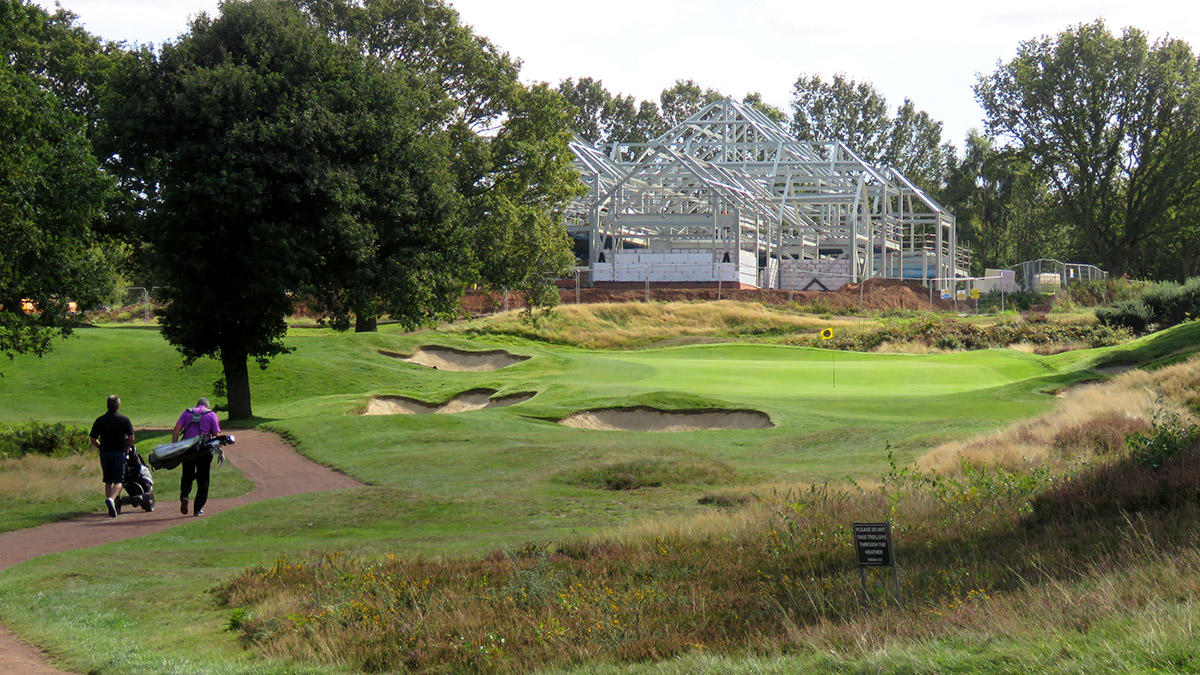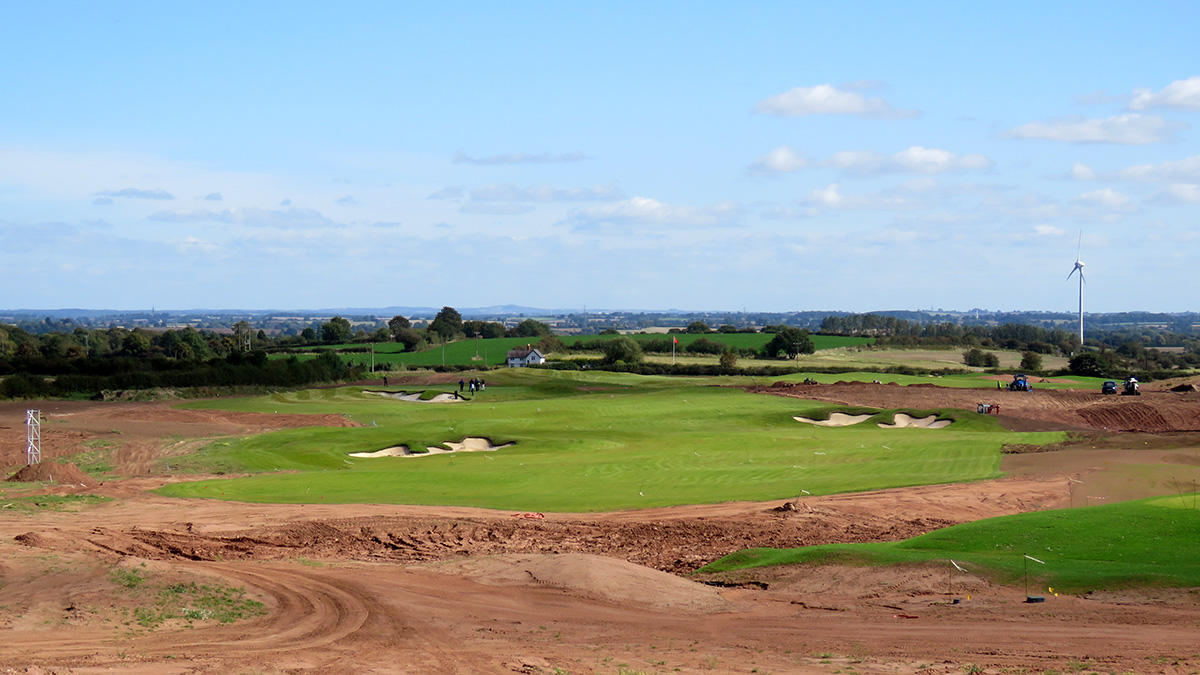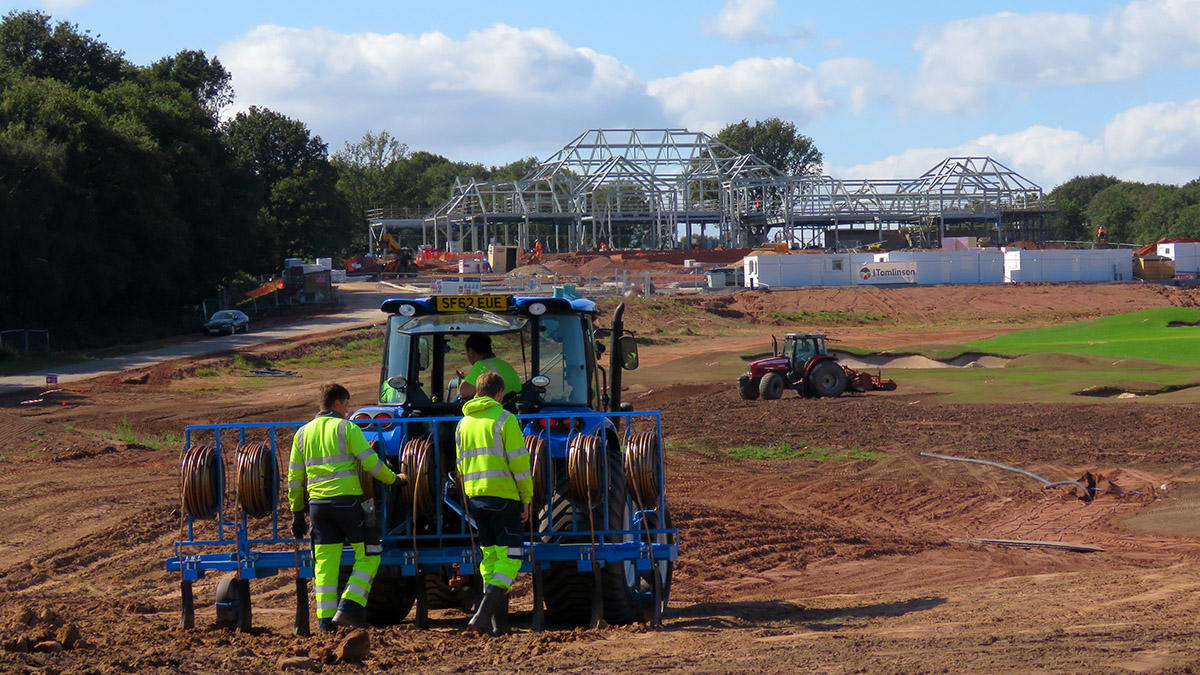- Homepage
- News and Features
- PODCAST: How HS2 has impacted historic Whittington Heath
PODCAST: How HS2 has impacted historic Whittington Heath
BIGGA's Karl Hansell visited Whittington Heath to discover how the historic course has been hugely impacted by the HS2 project.
Karl spoke to course manager Mark Fry and architect Jonathan Gaunt about the work that's taken place and you can listen their conversation on the latest edition of the Green Room Golf Course Podcast, by clicking on the image above.
Additionally, the following is a feature that appeared in Greenkeeper International, the monthly magazine for members of BIGGA...

Construction of a new clubhouse is underway at Whittington Heath
It’s safe to say that the HS2 railway scheme has been somewhat controversial since it was announced more than a decade ago.
There has been billions already spent and extensive delays, with no trains anticipated to actually begin running until 2026.The proposed route of the high‑speed railway has been a major cause for comment and campaigning, with no golf course being more affected than Whittington Heath, just outside of Birmingham.
The club’s historic clubhouse has been scheduled for demolition, while five holes will be lost as the route runs straight through the centre of the golf course.
Tasked with maintaining the course during the disruption and growing in the new holes that have been constructed is Course Manager Mark Fry, who succeeded longstanding Whittington Heath greenkeeper Trevor Morris in June 2019.
“Trevor was a very loyal member of staff and very well respected, so they’re big shoes to fill,” said Mark, 44, the former deputy head greenkeeper at Worplesdon in Surrey. “One of the main reasons I came up here was the challenge of building the new course. If I become successful at growing in a great new golf course and restoring heathland back on the existing course then I’ll have done my job.
“It’s a great challenge and I’m looking forward to seeing the end result. I think in five to seven years’ time, when the new course looks like the existing holes, I’ll be able to look back and be proud of what we achieved.” »
The design for the new holes has been produced by course architect Jonathan Gaunt, with John Greasley enlisted as constructors.
Rain Bird has been brought in to install irrigation, while Bruce Jamieson has also been utilised as an expert advisor.
“I first got involved here in 2012,” said Jonathan. “The guys at the club were really good because they allowed us to come up with a number of design options, enabling us to start from scratch. You’ll always get people who disagree with some points, but we got an agreement whereby I’d like to think that 98.5% of it was our design and the other bit was the club members providing some very sensible and useful feedback relating to them playing this course every day. Some of those guys are playing this course 150 to 200 times a year, so they know it better than us.”

The grow-in of fairways and greens has begun on a former area of farmland
A field that comprised farmland has been purchased adjacent to the existing course and it is there that the holes are being constructed.
Incorporated within that is also 10 hectares of mitigation land that will see heathland restored to the area, offsetting that lost by the construction of the railway elsewhere.
The project is being funded by HS2, but there are specific restrictions on what can take place, with a policy of ‘like for like’ replacement. That means Whittington Heath won’t suddenly become cash rich, but it has enabled them to benefit from refreshed facilities and up‑to‑date provision for the greenkeeping team.
One of the requirements of the construction was for the new course to be in play by spring 2022. To enable the club’s new greens to be at the required standard by that point, the construction team utilised a method that saw them repeatedly hollow core the existing greens and spread the corings on to the new surfaces.
Expert advisor Bruce Jamieson explained why this method was chosen: “Anyone who’s built a new green on an existing course and then seeded it from new will have seen it go through a transition that takes anything from five to 10 years. The new green gets Poa annua invasion and you get a mottled appearance until slowly the green unifies again.
“The club’s brief to me was to give them greens that were as similar to the existing ones as possible. We chose to take cores from the existing greens, which will import poa and bent, and we’ll then have an existing sward much quicker that’s very similar to the existing greens.
“In addition to that, it should help mitigate the problems of take‑all patch on the new greens, which you normally get on bentgrass, by bringing some of the beneficial fungi in the cores. This will prevent that from being a major problem for the first three to five years.”
Whittington Heath is a Harry Colt design and Jonathan explained how the new holes were influenced by the history of the club.
“I think we’ve realised that traditional designs are probably less intensive to maintain,” he said. “When it comes to aesthetics, those old black and white photographs are romantic to look at, but there was definitely also a move in the US when people like Coore and Crenshaw started doing rough edge golf courses, moving away from the formulaic American design to a more natural, British style. That has snowballed and I’m working alongside really good architects who have been doing a similar thing, bringing back the original styling and shaping that you would have seen in the 1920s and ‘30s.
“It works on these golf courses, especially Whittington Heath, because it’s a traditional heathland golf course and so that ethos fits.”
Although a Colt ethos will be restored at the club and over the coming decade the heathland characteristics will become more evident as a process of tree removal takes place, the design of the new holes and the changes made to the existing ones are an evolution of Colt’s principles, not a direct replica.

Laying fairway drainage pipes
Jonathan explained: “We had a certain amount of reluctance from the membership about changing things, but there’s nothing we can do about it and technology has moved on significantly, even in the last five years. The way people are hitting golf balls these days means many fairway bunkers are redundant. We’ve moved them to a more influential location, down the fairway, and that’s starting to impact those guys who are hitting 250 or 260‑metre drives.”
One of the barriers to the planting of heather is the pH balance of the area. Normal farmland is very fertile soil and heather won’t grow on that, so the contractor scraped the top 20 to 40cm of topsoil away, exposing a sandy subsoil. However, testing revealed that the pH is too high, around 6.5, and heather prefers a more acidic soil, of around 4.5 to 5. To alter the balance, the team is applying granules of sulphur to the soil and then, within the heathland mix, there will be an acidifier called Aquafix, which will maintain the new acidity level.
“We’re working with a team of ecologists who have been advising us throughout the project and they said this is the largest heathland recreation project they’ve ever worked on,” said Jonathan.
Assisting the heather as it establishes on the site will be a Rain Bird irrigation system that features 252km of drip irrigation. On the new holes the irrigation system encompasses the entire area, which the club has said will speed up the grow‑in process but which will also be a » valuable asset in the years
to come.
Overseeing the grow‑in as course manager will be Mark, who was deputy head greenkeeper at Worplesdon for eight years. He had a baptism of fire after starting the role halfway through the building process but was ready for the challenge ahead, despite this being his first large scale construction project.
“I’ve built one new green and a couple of tees or bunkers, but this is on a much bigger scale,” said Mark. “The key is going to be applying the correct fertiliser and amount of water. We’ll have to keep the fertiliser topped up constantly because with a new green your fertiliser tends to leak through, so you’ve got to keep a close eye on it.
“Alongside my experience at Worplesdon, I thought this would be a good opportunity to get my name out there. In five to seven years’ time the heathland will be established and it will look amazing. To have my name put towards that will be absolutely fantastic.
“But it is not just the new course as there’s a lot of work to be done on the old course too.
“Forty years ago it was a proper heathland course, but the trees have developed and the committee and members want to turn it back into a heathland course. They’ve hired me to do that and I’ve given myself five to seven years to complete that project. Once I do I’m going to be very proud and hopefully so will the members.”
The decision to build a high‑speed railway through the centre of Whittington Heath wasn’t ideal, but it’s provided a number of opportunities for the club and for the greenkeeping team that could well benefit the club and their careers for decades to come.
Author

Karl Hansell
Karl has been head of communications for BIGGA since March 2016. His duties include editing the monthly Greenkeeper International magazine, in addition to other communications activities for the association.
Five golf courses are affected by HS2 Phase 1:
Aylesbury Park – existing course to close
Buckinghamshire – temporary closure of two holes during works
Ruislip – 18‑hole course to be reconfigured as nine‑hole academy course
Uxbridge – 12‑hole course affected by haul road and utility works
Whittington Heath – 18‑hole course reconfigured onto adjoining land
Other courses will be affected by HS2 Phase 2
